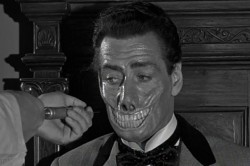Cinema | October 26th, 2016

This summer Mill Creek Entertainment released four William Castle films on bargain double-feature Blu-rays. Several additional Castle movies are available from different companies. The best introduction to his work is probably the disc containing “Homicidal” and “Mr. Sardonicus.” Both are 1961 productions and make ideal Halloween season viewing.
Producer-director William Castle made a wide variety of films and TV programs from 1939 through 1975. But he gained a public reputation with the horror films he made in the late 1950s and 1960s for his own production company, many of which had an intentionally campy, tongue-in-cheek attitude. He was especially noted for devising flamboyant promotional gimmicks to help exploit his horror films, providing a sense of showmanship that made moviegoing a special event and has been rarely seen in movie theatres for decades.
For his first independent thriller, “Macabre” (1958), he offered audience members a $1000 life insurance policy against dying from fright. With “House on Haunted Hill” (1959) he convinced many theatres to have a life-size skeleton fly from the screen over the audience on a wire at a key moment. For “The Tingler” (1959) he had random theatre seats wired to vibrate when the monster gets loose. In “13 Ghosts” (1960), although shot in black-and-white, scenes showing the ghosts were printed in blue with the ghosts in red. Audience members could then choose to look through a special “ghost viewer” and have the ghosts invisible by looking through a red filter or visible by looking through a blue filter.
In 1960 Alfred Hitchcock’s “Psycho” revolutionized the horror thriller. Despite touches of dark, ironic humor, it was mostly deadly serious and its huge box-office success started the trend of slasher-murders by psychotic killers that remains a core element in horror films today.
William Castle was among the first to capitalize upon the notoriety of “Psycho” with his “Homicidal” the following year. He includes several scenes that closely parallel scenes in “Psycho” and has as many or more unexpected twists, surprise shocks, and shifts in plot direction. Ironically, Hitchcock is said to have been inspired to make “Psycho” because of the popular low-budget horror films made by Castle and by Roger Corman.
“Homicidal” does not have the lighthearted campiness of many of his other films, except for the Hitchcock-like personal introduction with William Castle addressing the audience, and his brief gimmick just before the film’s climax. When a key character is just about to enter the killer’s house to learn what is happening, a 45-second timer appears on the screen as a “fright break” to give time for squeamish viewers to leave the auditorium in shame and claim a refund on their ticket.
It would spoil the many surprises to discuss the plot in much detail. The film begins with a prologue set in 1948 showing two children, and then the action jumps to the present (1961) to what at first seems like a completely unrelated story. Very quickly a mysterious situation is set up, only to be interrupted by a brutal killing that makes the film all the more intriguing. Castle and screenwriter Robb White gradually reveal backstory, psychological implications, and other clues as the plot unfolds and grows more complex, with numerous twists along the way.
Performances are effective (particularly Jean Arless, later known as Joan Marshall), if lacking the star power of “Psycho.” Critical reaction was mixed but Time Magazine preferred the film over “Psycho” and put “Homicidal” on its list of the year’s ten best.
Mill Creek’s Blu-ray, using a Sony HD transfer, has a very good image and good sound. Unfortunately there are no bonus features besides the appropriate co-feature “Mr. Sardonicus.”
HOMICIDAL on Blu-ray -- Movie: A- / Video: A- / Audio: A- / Extras: F
Only four months after the release of “Homicidal,” Castle’s “Mr. Sardonicus” (1961) hit theatre screens. It was a return to a more traditional gothic thriller, but again is played as straight melodrama rather than camping it up (except for Castle’s amusing personal introduction at the start, and the gimmick near the end where Castle asks the audience to vote on the fate of the villain).
The film’s 1880 setting is very much in tune with the wave of horror films coming from Britain’s Hammer Films and Roger Corman at American International Pictures around that time, and harkens back to the classic thrillers from Universal and RKO in the 1940s.
The plot borrows a major premise from Victor Hugo’s “The Man Who Laughs” (made into a brilliant film by Paul Leni in 1928). This it combines with the familiar formula of idealistic doctors whose medical experiments push the boundaries of scientific knowledge, and the trope of superstitious villagers fearfully living in the shadow of a secluded castle where a mysterious aristocrat is believed to be doing unsavory things. In short, a famous English physician is urgently summoned to a central European castle by his former fiancée, now married to a mysterious baron who demands his services. The doctor learns various secrets after his arrival and the plot holds a few thrills as it unfolds to its Twilight Zone-like conclusion. Castle’s direction holds interest throughout, and the acting is satisfactory, with Oskar Homolka standing out as the servant of Sardonicus.
On the same Mill Creek disc as “Homicidal,” this edition of “Mr. Sardonicus” also looks very good, but oddly not quite as good as Mill Creek’s previous Blu-ray release of it three years ago paired with “The Brotherhood of Satan.” Again there are unfortunately no supplements.
MR. SARDONICUS on Blu-ray -- Movie: B+ / Video: A- / Audio: A- / Extras: F
December 29th 2025
December 29th 2025
December 16th 2025
December 9th 2025
December 2nd 2025

_(1)_(1)_(1)_(1)__293px-wide.jpg)


_(1)__293px-wide.jpg)
_(1)_(1)_(1)__293px-wide.jpg)